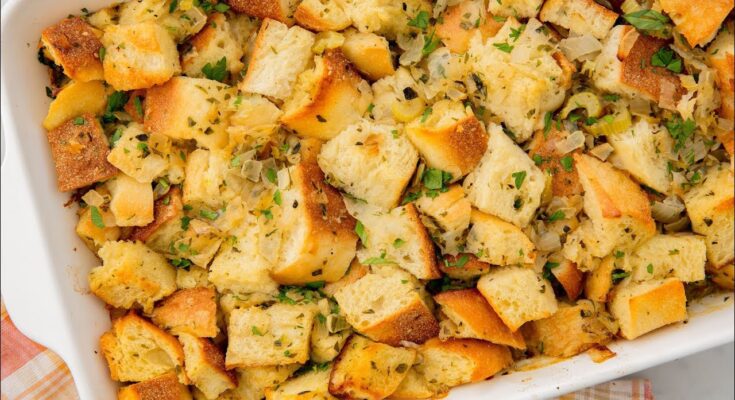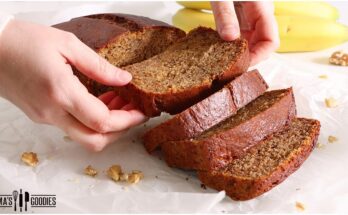Best Stuffing Recipe: Stuffing has been a beloved dish for generations, especially during holidays like Thanksgiving and Christmas. But it’s not just for special occasions! A well-made stuffing can elevate any meal, adding rich flavors and textures that complement the main course.
Instead of relying on boxed mixes, learning how to make stuffing from scratch gives you full control over the taste and ingredients.
Ready to create the perfect stuffing? Let’s dive in!
Ingredients for the Perfect Stuffing
The right combination of ingredients can make or break your stuffing. Here’s what you’ll need to get started:
Key Ingredients:
- Bread: A loaf of white bread, sourdough, or French bread (dried or stale)
- Butter: ½ cup (for richness)
- Onions: 2 large, diced
- Celery: 4 stalks, chopped
- Garlic: 2 cloves, minced
- Chicken or vegetable broth: 2-3 cups
- Eggs: 2 (helps bind the stuffing)
- Fresh herbs: Sage, thyme, parsley (chopped)
- Salt and pepper: To taste
Optional Add-ins:
- Cooked sausage or bacon for extra flavor
- Diced apples or cranberries for a hint of sweetness
- Chopped walnuts or pecans for crunch
Having fresh and flavorful ingredients is crucial to making a delicious stuffing.
Tools You’ll Need
Before you get started, make sure you have these tools on hand:
Essential Kitchen Tools:
- A large mixing bowl
- Cutting board and sharp knife
- Measuring cups and spoons
- A large skillet or sauté pan
- Baking dish (9×13 inch recommended)
- Aluminum foil
Substitute Tools:
Don’t have a skillet? A large saucepan will work. No baking dish? Try using a casserole dish.
How to Make Stuffing – Step by Step Guide
Step 1: Preparing the Bread Base
The bread forms the foundation of your stuffing, so it’s important to get this step right.
- Choose the bread: You can use white, wheat, sourdough, or even cornbread. Avoid overly soft sandwich bread as it can become mushy.
- Dry the bread: Cut the bread into 1-inch cubes. Spread them out on a baking sheet and leave them to dry overnight. Alternatively, bake at 250°F for 20-30 minutes until dry and slightly crispy.
Why dry bread? It absorbs the flavors better than fresh bread, giving your stuffing that perfect balance of moisture and texture.
Step 2: Preparing the Vegetables
Vegetables provide essential flavor and texture to stuffing. The classic combination of onions and celery works beautifully.
- Chop the vegetables: Dice the onions and chop the celery into small, even pieces. Mince the garlic.
- Sauté: In a large skillet, melt 4 tablespoons of butter over medium heat. Add the onions and celery. Cook for about 5-7 minutes until softened. Add the garlic and cook for another 1-2 minutes.
Cooking the vegetables softens their texture and brings out their natural sweetness, which adds depth to the stuffing.
Step 3: Cooking the Aromatics
This step is all about infusing your stuffing with rich, savory flavors.
- Add herbs: Sprinkle in the chopped sage, thyme, and parsley. Stir well to combine with the sautéed vegetables.
- Season: Add salt and pepper to taste. Don’t overdo it—you can adjust later after mixing with the bread and broth.
Cooking the herbs releases their oils, giving your stuffing an irresistible aroma that fills the kitchen with holiday cheer.
Step 4: Adding Liquid Ingredients
The right amount of liquid is key to achieving moist but not soggy stuffing.
- Heat the broth: Warm 2-3 cups of chicken or vegetable broth on the stove.
- Add melted butter: If you love rich stuffing, stir in extra melted butter for added flavor.
- Mix in eggs: Lightly beat 2 eggs and stir them into the warm broth. The eggs help bind the stuffing, giving it structure.
Adding warm broth ensures the bread absorbs the liquid evenly. This helps you avoid dry spots when baking.
Step 5: Combining Ingredients
Now it’s time to bring everything together!
- In a large bowl: Add the dried bread cubes.
- Mix: Pour the sautéed vegetables and broth mixture over the bread. Use a spoon or your hands to gently toss until all the bread is evenly coated.
- Check moisture: The bread should feel damp but not soggy. Add more broth if needed.
This step ensures that every bite of stuffing is full of flavor and perfectly textured.
Step 6: Adjusting the Moisture Level
Getting the perfect moisture balance is crucial. You want stuffing that’s moist and tender on the inside but not overly wet or gummy.
- Test the consistency: After mixing, gently press a handful of stuffing in your palm. If it holds its shape without leaking liquid, you’re on the right track.
- Adjust if necessary:
- If the stuffing is too dry, gradually add more broth (¼ cup at a time) until the desired consistency is reached.
- If it’s too wet, add a few more bread cubes to absorb excess liquid.
Remember, stuffing will continue to cook and absorb moisture in the oven, so it’s better to err on the side of slightly moist.
Step 7: Baking the Stuffing
Now comes the part where all the ingredients meld together in the oven. You can choose to bake your stuffing inside the turkey or separately in a dish.
- Preheat the oven: Set your oven to 350°F (175°C).
- Transfer to a dish: Lightly grease a 9×13-inch baking dish and spread the stuffing mixture evenly inside.
- Cover and bake: Cover the dish with aluminum foil to retain moisture. Bake for about 30 minutes.
- Crisp the top: Remove the foil and continue baking for another 15-20 minutes until the top turns golden brown and crispy.
Tip: If you prefer a stuffing with extra crunch, sprinkle some melted butter on top before the final bake.
Step 8: Final Touches and Serving
Your stuffing is almost ready to steal the show!
- Check for doneness: The internal temperature should reach 165°F if baked inside a turkey. For stuffing baked in a dish, it should be hot and bubbly with a crispy golden crust.
- Let it rest: Allow the stuffing to cool for about 5-10 minutes before serving. This helps the flavors settle and makes it easier to portion.
- Garnish: Sprinkle with freshly chopped parsley or a dash of black pepper for a final touch.
Serve your stuffing warm alongside turkey, roast chicken, or any main dish of your choice.
Common Variations of Stuffing Recipes
Stuffing recipes can be incredibly versatile! Here are a few popular variations:
- Cornbread Stuffing: Use crumbled cornbread instead of white bread for a southern twist.
- Sausage Stuffing: Add cooked and crumbled Italian sausage for extra savory depth.
- Vegetarian Stuffing: Skip the chicken broth and use vegetable stock. You can also add mushrooms for an umami boost.
- Fruit and Nut Stuffing: Incorporate dried cranberries, raisins, or chopped apples for sweetness. Walnuts, pecans, or almonds add a nice crunch.
- Gluten-Free Stuffing: Use gluten-free bread or cornbread to accommodate dietary restrictions.
Tips for Success
Want your stuffing to be the best at the table? Follow these tips to avoid common pitfalls:
- Use quality bread: Stale or dried bread works best to absorb liquid without turning to mush.
- Don’t overmix: Be gentle when combining ingredients to preserve the texture of the bread cubes.
- Bake uncovered at the end: This step ensures you get that golden-brown, slightly crisp top.
- Prep ahead: You can sauté the vegetables and toast the bread cubes a day in advance to save time.
Serving Suggestions
Stuffing is a versatile side dish that pairs beautifully with many main courses. Here are some ideas:
- Traditional Thanksgiving Meal: Serve alongside roast turkey, mashed potatoes, cranberry sauce, and gravy.
- Roast Chicken Dinner: Stuffing works well with a simple herb-roasted chicken.
- Pork or Beef Roast: Add a hearty touch to your Sunday roast with stuffing on the side.
- Vegetarian Feast: Pair with roasted vegetables, mushroom gravy, and a hearty salad.
Storage Tips: Leftover stuffing can be stored in an airtight container in the refrigerator for up to 4 days. Reheat in the oven at 350°F for about 15-20 minutes to restore its texture.
FAQs about Best Stuffing Recipe
What bread is best for stuffing?
The best bread for stuffing is dry and sturdy. Consider using a mix of day-old white bread, whole wheat, or sourdough for a balance of flavor and texture.
How do I make my stuffing moist?
To ensure your stuffing is moist, use enough broth to saturate the bread without making it soggy. A good rule of thumb is about 1 cup of broth for every 4 cups of bread cubes. Also, cover the stuffing with foil while baking to lock in moisture.
Can I prepare my stuffing in advance?
Yes, you can prepare your stuffing the day before. Assemble it in your baking dish, cover it tightly, and refrigerate. Bake it the next day, adding an extra 10-15 minutes to the cooking time.
What can I add to my stuffing for more flavor?
Enhance your stuffing with sautéed onions, celery, and carrots. Herbs like sage, thyme, and rosemary add a classic flavor. For a unique twist, try adding chopped apples, cranberries, or nuts.
Is it safe to stuff my turkey?
For safety, it’s best to cook stuffing separately in a baking dish. If you do stuff your turkey, ensure the center of the stuffing reaches a safe temperature of 165°F (74°C) to prevent any foodborne illnesses.
How long can I store leftover stuffing?
Leftover stuffing can be kept in the refrigerator for up to four days. Make sure to reheat it to an internal temperature of 165°F (74°C) before serving.
Conclusion
Congratulations! You’ve just learned how to make the perfect stuffing from scratch. Whether it’s for a holiday feast or a comforting weeknight dinner, homemade stuffing is a crowd-pleaser that brings warmth and flavor to the table. Don’t be afraid to get creative with ingredients and tailor the recipe to your taste. The possibilities are endless!



